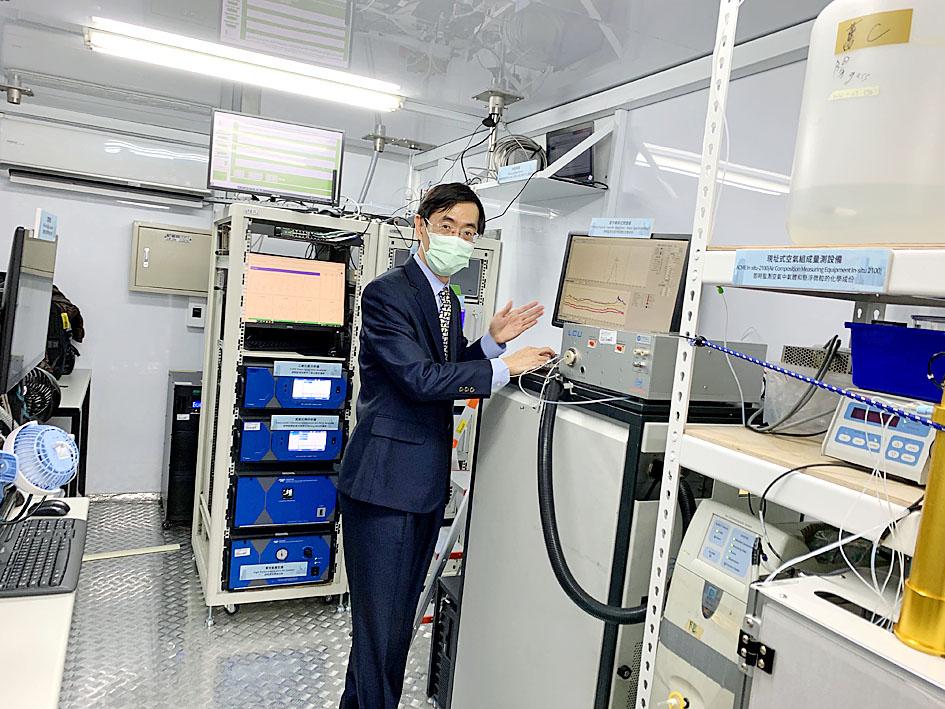An air quality monitoring station has been set up in Taichung to determine the composition of air pollutants in the city, researchers said on Sunday.
The Surface Air Pollution Research Station, which was established by Academia Sinica’s Research Center for Environmental Changes and the Taichung City Environmental Protection Bureau at a cost of NT$100 million (US$3.62 million), would collect and analyze air samples over the next four years, said Charles Chou (周崇光), CEO of the center’s Air Quality Research Center.
In a project led by Academia Sinica researchers, the station would take precise measurements of more than 100 types of fine particulates smaller than 2.5 micrometers (PM2.5) and ozone precursors, which would help the city devise policies to combat sources of air pollution, he said.

Photo: Tsai Shu-yuan, Taipei Times
Average concentrations of PM2.5 in the city have decreased annually over the past several years, but people have grown more aware of the dangers of air pollution, the effects of which are more obvious during the fall and winter months, he said, adding that air pollution still affects visibility in central and southern Taiwan during the winter.
“The complex physical and chemical properties of air pollution mean it is necessary to perform precise analysis on samples to come up with effective policies to combat it,” he said.
Taichung’s geographical location, which faces winds from the land and sea, the urban heat island effect, and valley and monsoon winds, adds to the complexity of understanding air pollution in the city, he said.
The station, which is the first of its kind in Taiwan, was set up on the roof of Taichung’s Second Municipal Government Building.
The project would involve research into the physical and chemical processes of air pollution in central Taiwan, including sources of emission, and how pollutants are transmitted and transformed, center director Chen Yue-gau (陳于高) said.
Researchers would use satellite and surface telemetry technology, optical radars, Internet of Things devices and artificial intelligence, he said.
The team would also use flue samples to analyze the composition of volatile organic compounds, he said.
The annual average concentration of PM2.5 in Taichung dropped to 15.4 micrograms per cubic meter in 2020, which is near the national standard of 15 micrograms per cubic meter, Taichung Environmental Protection Bureau Director Chen Hung-yi (陳宏益) said.
“However, the closer we get to that standard, the more difficult it becomes to further lower the PM2.5 level. Last year the level even rose in some parts of the country,” he said.
Ozone pollution is also a growing problem for several counties and municipalities nationwide, he said.

Taiwanese scientists have engineered plants that can capture about 50 percent more carbon dioxide and produce more than twice as many seeds as unmodified plants, a breakthrough they hope could one day help mitigate global warming and grow more food staples such as rice. If applied to major food crops, the new system could cut carbon emissions and raise yields “without additional equipment or labor costs,” Academia Sinica researcher and lead author the study Lu Kuan-jen (呂冠箴) said. Academia Sinica president James Liao (廖俊智) said that as humans emit 9.6 billion tonnes of carbon dioxide compared with the 220 billion tonnes absorbed

The Taipei Mass Rapid Transit (MRT) Wanda-Zhonghe Line is 81.7 percent complete, with public opening targeted for the end of 2027, New Taipei City Mayor Hou You-yi (侯友宜) said today. Surrounding roads are to be open to the public by the end of next year, Hou said during an inspection of construction progress. The 9.5km line, featuring nine underground stations and one depot, is expected to connect Chiang Kai-shek Memorial Hall Station to Chukuang Station in New Taipei City’s Jhonghe District (中和). All 18 tunnels for the line are complete, while the main structures of the stations and depot are mostly finished, he

Taipei is to implement widespread road closures around Taipei 101 on Friday to make way for large crowds during the Double Ten National Day celebration, the Taipei Department of Transportation said. A four-minute fireworks display is to be launched from the skyscraper, along with a performance by 500 drones flying in formation above the nearby Nanshan A21 site, starting at 10pm. Vehicle restrictions would occur in phases, they said. From 5pm to 9pm, inner lanes of Songshou Road between Taipei City Hall and Taipei 101 are to be closed, with only the outer lanes remaining open. Between 9pm and 9:40pm, the section is

China’s plan to deploy a new hypersonic ballistic missile at a Chinese People’s Liberation Army Rocket Force (PLARF) base near Taiwan likely targets US airbases and ships in the western Pacific, but it would also present new threats to Taiwan, defense experts said. The New York Times — citing a US Department of Defense report from last year on China’s military power — on Monday reported in an article titled “The missiles threatening Taiwan” that China has stockpiled 3,500 missiles, 1.5 times more than four years earlier. Although it is unclear how many of those missiles were targeting Taiwan, the newspaper reported